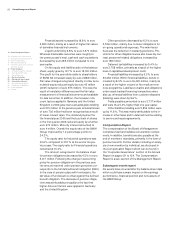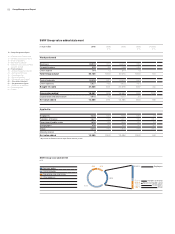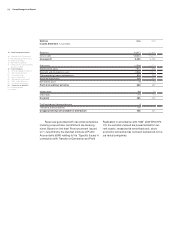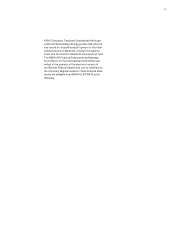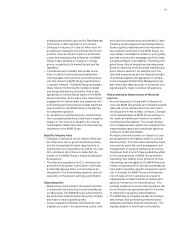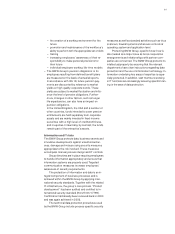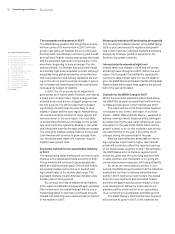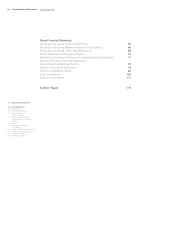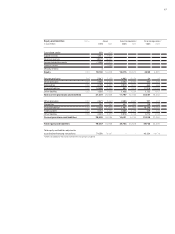BMW 2006 Annual Report Download - page 59
Download and view the complete annual report
Please find page 59 of the 2006 BMW annual report below. You can navigate through the pages in the report by either clicking on the pages listed below, or by using the keyword search tool below to find specific information within the annual report.58 Group Management Report
10 Group Management Report
10 A Review of the Financial Year
12
General EconomicEnvironment
15 Review of operations
38 BMW Stock and Bonds
41 Disclosures pursuant to §289 (4)
and §315 (4) HGB
43 Financial Analysis
43 – Internal Management System
44 – Earnings performance
46 – Financial position
48 – Net assets position
50 – Subsequent events report
50 – Value added statement
53 – Key performance figures
54 – Comments on BMW AG
58 Risk Management
62 Outlook
Risk management in the BMW Group
As a globally operating enterprise, the BMW Group
is confronted with numerous risks. At the same
time, opportunities can arise from changing circum-
stances, which the BMW Group endeavours to an-
ticipate and exploit to improve its competitive position.
Business risks are only consciously entered into
when it is considered that the value of the business
can be increased and the potential outcome can
be controlled.The Board of Management and Super-
visory
Board are regularly informed about risks
which could have a significant impact on business
development.
In order to identify, evaluate and document the
main risks, the BMW Group uses a comprehensive
risk management system which involves the following
processes:
– Business decisions are reached after in-depth
project analyses, including detailed information
concerning potential risks and opportunities, have
been taken into consideration. In addition, as part
of the long-term planning strategy and short-
term forecasting procedures, the risks and oppor-
tunities attached to specific business activities
are evaluated and used as the basis for setting
targets and implementing appropriate risk-miti-
gation measures.
– The Group reporting system keeps all decision-
makers fully informed and up-to-date about per-
formance against targets and highlights changes
affecting the market and competitors. By
con-
tinuous monitoring of critical success factors,
variances are identified at an early stage, thus
allowing appropriate counter-measures to be im-
plemented.
– Overall risk management is supervised by the
corporate controlling department and is reviewed
for its appropriateness and effectiveness by exter-
nal auditors and by the Group’s internal audit de-
partment.Throughout the BMW Group, a network
of risk managers is in place, regularly carrying
out risk reviews to identify and analyse significant
risks. The results of the reviews are summarised
in a separate risk report which is then presented
to the Board of Management.
– By regularly sharing experiences with other com-
panies, the BMW Group ensures that innovative
ideas and approaches flow into the risk
manage-
ment system and that operational riskmanagement
is subjected to continual improvement.
At present, no risks have been identified which could
threaten the existence of the Group or which could
have a materially adverse impact on the net assets,
financial position or results of operations of the Group.
However, risks can never be entirely ruled out.
In the course of its business activities, the BMW
Group is exposed to various types of risk:
Risks relating to the general economic
environment
– As a result of its global activities, the BMW Group
is affected by global economic factors such as
changes in currency parities and changes on the
financial markets. The US dollar is particularly
important for the development of group revenues
and earnings and represents the main single
source of risk within the BMW Group’s foreign
currency portfolio. Exchange rate fluctuations of
the British pound and the Japanese yen in relation
to the euro can also have a material impact on
earnings. Based on group forecasts, these three
currencies account for some 80% of the foreign
currency exposure of the BMW Group.
The BMW Group manages currency risks at both
a strategic and an operating level.
From a strategic point of view, i.e. in the medium
and long-term, the BMW Group endeavours to
manage foreign exchange risks by “natural hedg-
ing”, in other words by increasing the volume of
purchases denominated in foreign currency or
increasing the volume of local production. Cur-
rency risks are hedged in the short and medium
term on the financial markets. Hedging transac-
tions are entered into only with financial partners
of first-class credit standing. The nature and
scope of such measures are set out in guidelines
applicable throughout the BMW Group. A cash-
flow-at-risk model and scenario analyses are
used to measure exchange rate risks. These in-
struments are also used as part of the process of
currency management for the purpose of taking
business decisions.
– Changes in the international commodity markets
also have an impact on the business development
of the BMW Group. In order to safeguard the
sup-
ply of production materials and to minimise the
cost risk, the commodity markets relevant for the
BMW Group are closely monitored.The market price
trend of precious metals such as platinum, palla-
dium
and rhodium, for which appropriate hedging
Risk Management




